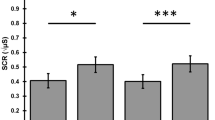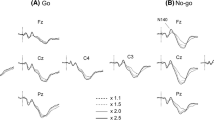Abstract
Research on the effects of self-regulation of slow potentials (SP) and event-related potentials (ERP) has failed to look at the possible interactions of these two kinds of brain potentials. The present study investigated such interactions by recording both ERP and SP potential changes in an operant ERP conditioning paradigm. Ten subjects participated in two conditions that were designed to differentially manipulate attention to the stimuli. In the operant conditioning task, subjects received auditory feedback as they attempted to increase the ERP amplitude at 180 msec poststimulus (P180), which was elicited by a subpainful shock stimulus to the forearm over 250 trials. In the distraction task, subjects were instructed not to attend to stimuli or feedback tones, but rather received and were tested on reading materials. Attention, as manipulated by these tasks, was not a determinant of changes in ERP amplitude since there were no significant differences in the size of P180 between attention conditions. While no significant change in the mean ERP amplitude occurred, subjects were able to produce ERPs above criterion threshold significantly more often during trials in the conditioning task than in the reading task. Thus, there was evidence of some learning. The difference in wave forms between hit and miss trials indicates a latency shift (with misses having a later ERP peak). This may indicate that latency, rather than, or in addition to, amplitude, is shaped during conditioning procedures. In addition, the CNV that developed between the shock stimulus and the feedback signal during conditioning was significantly larger in amplitude than in the distraction condition. This is taken as evidence of increased attention during conditioning. Since hit trials demonstrated larger contingent negative variation (CNV) amplitudes, production of CNVs may be instrumental in mediating hits. Therefore, attentional mechanisms may play a role in successful ERP self-regulation. No correlations were found involving P180, CNVs, or tonic slow potential shifts. Changes in tonic DC levels showed a suggestive trend between conditions. Although both conditions began with a negative shift, during conditioning the negativity increased, while during distraction the tonic level went to positivity. These trends support the hypothesis that attention and arousal increased during conditioning. The possible reasons for the lack of significant correlations between ERP and tonic or phasic slow potential changes in this paradigm are discussed
Similar content being viewed by others
References
Callaway, E. (1975).Brain electrical potentials and individual psychological differences. New York: Grune and Stratton.
Caspers, H., Speckmann, & Lehmenkuler, E. J. (1980). Electrogenesis of cortical DC potentials.Progress in Brain Research, 54 3–15.
Donchin, E. (1979). Event-related brain potentials: A tool in the study of human information processing. In H. Begleiter (Ed.),Evoked brain potentials and behavior (pp. 13–38). New York: Plenum Press.
Elbert, T., Rockstroh, B., Lutzenberger, W., & Birsbaumer, N. (1980). Biofeedback of slow cortical potentials.Electroencephalography and Clinical Neurophysiology, 18 293–301.
Ferguson, G. (1971).Statistical analysis in psychology and education (p. 324). New York: McGraw-Hill.
Finley, W. W. (1983). Biofeedback of very early potentials from the brainstem. In T. Albert, B. Rockstroh, W. Lutzenberger, & N. Birbaumer (Eds.),Self regulation of the brain and behavior. Berlin: Springer-Verlag.
Finley, W. W., & Johnson, G. (1983). Operant control of auditory brainstem potentials in man.International Journal of Neuroscience, 21 161–170.
Gaillard, A. W. K., & Naatanen, R. (1980a). Some baseline effects on the CNV.Biological Psychology, 10 31–39.
Gaillard, A. W. K., & Naatanen, R. (1980b). The effect of background slow potential shifts on event-related potentials. In H. Kornhuber & L. Deecke (Eds.),Progress in brain research (pp. 364–367). Amsterdam: Elsevier/North-Holland Biomedical Press.
Karrer, R., & Ivins, J. (1976). Steady potentials accompanying perception and response in mentally retarded and normal children. In R. Karrer (Ed.),Developmental psychophysiology of mental retardation (pp. 361–417). Springfield: Thomas.
Karrer, R., Kohn, H., & Ivins, J. (1973). Effects of varying the stimulus and response contingencies on the CNV. IN W. C. McCallum & J. R. Knott (Eds.),Event related slow potentials and behavior. Electroencephalography and Clinical Neurophysiology (pp. 39–43), (Suppl. 33).
Rockstroh, B., Birsbaumer, N., Elbert, T., & Lutzenberger, W. (1984). Operant control of EEG and event-related and slow brain potentials.Biofeedback and Self-Regulation, 9 139–160.
Rockstroh, B., & Lutzenberger, W. (1984). Self regulation of electrical brain activity. In T. Elbert, B. Rockstroh, W. Lutzenberger, & N. Birbaumer (Eds.),Self regulation of the brain and behavior. Berlin: Springer-Verlag.
Rosenfeld, J. P., Dowman, R., Silvia, R., & Heinricher, M. (1984). Operantly controlled somatosensory brain potentials: Specific effects on pain processes. In T. Elbert, B. Rockstroh, W. Lutzenberger, & N. Birbaumer (Eds.),Self regulation of the brain and behavior (pp. 164–180). Berlin: Springer-Verlag.
Rosenfeld, J. P., Silvia, R., Weitkunat, R., & Dowman, R. (1984). Operant control of human somatosensory evoked potentials alters experimental pain perception.Advances in Pain Research and Therapy, 8.
Sutton, S., & Ruchkin, D. S. (1984). The late positive complex — Advances and new problems. In R. Karrer, J. Kohen, & P. Tueting (Eds.),Brain and information: Event related potentials. (Annals of New York Academy of Sciences, Vol. 25, pp. 1–23).
Author information
Authors and Affiliations
Additional information
This research was partially supported by NICHD Grant HD 15327 to R. Karrer, NIH Grant DE05204 to J. P. Rosenfeld, and the Office of Social Science Research at University of Illinois at Chicago. Appreciation is extended to G. Dombrowski for his assistance in data analysis.
Rights and permissions
About this article
Cite this article
Douros, C., Karrer, R. & Rosenfeld, J.P. Effects of attention and slow potential shifts on self-regulation of event-related potentials. Biofeedback and Self-Regulation 12, 39–49 (1987). https://doi.org/10.1007/BF01000077
Received:
Issue Date:
DOI: https://doi.org/10.1007/BF01000077




